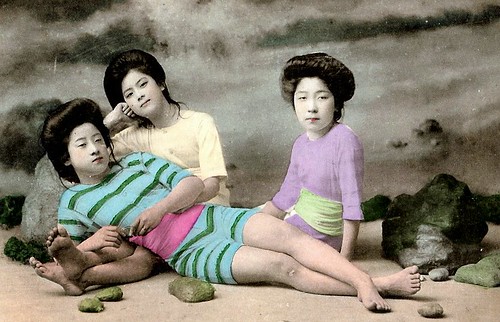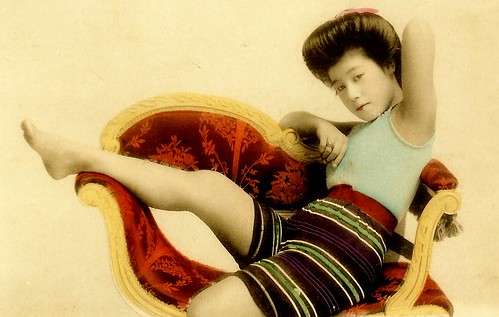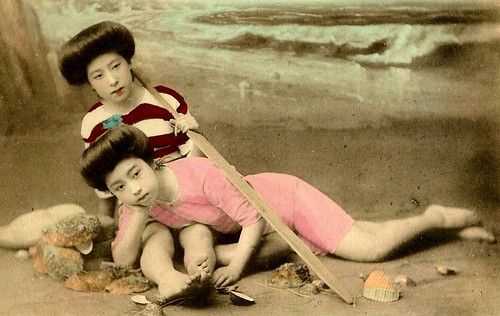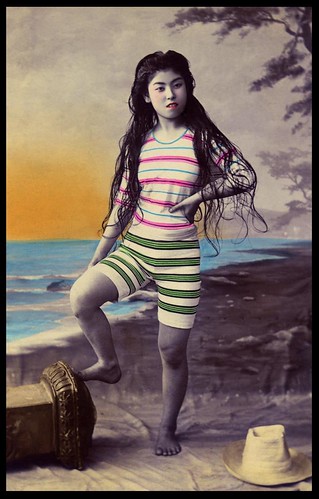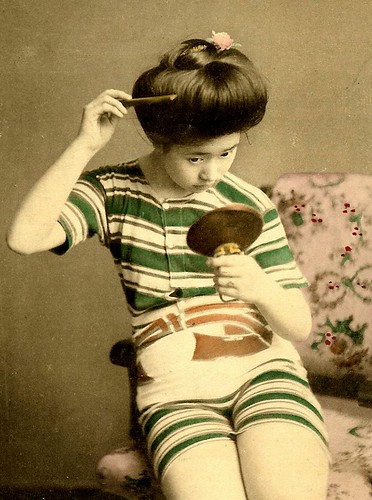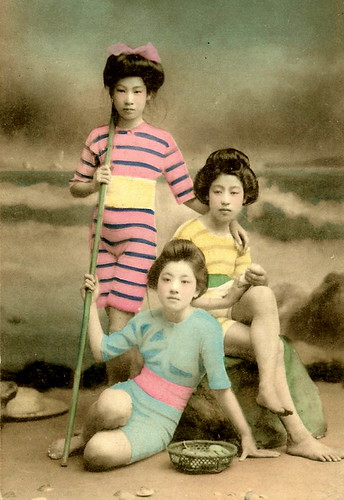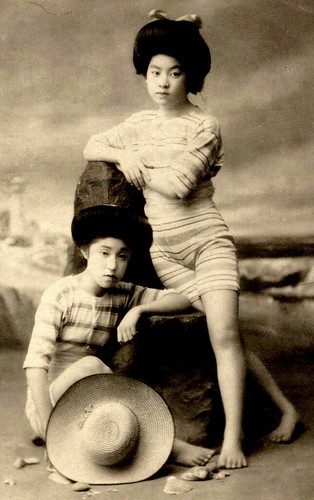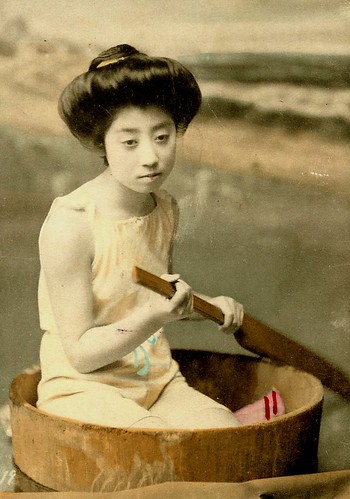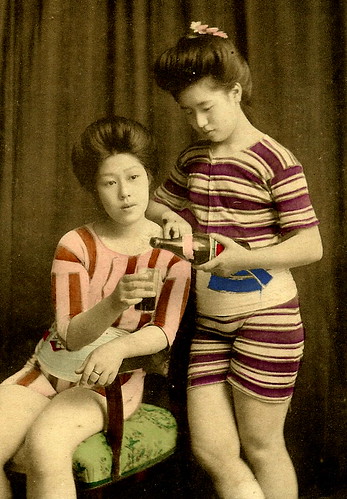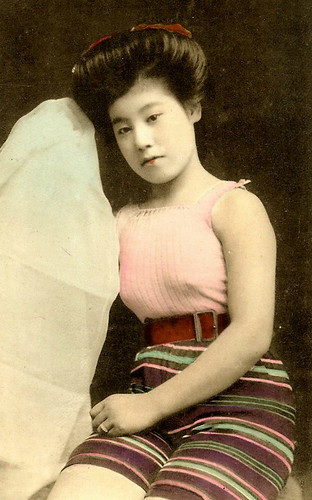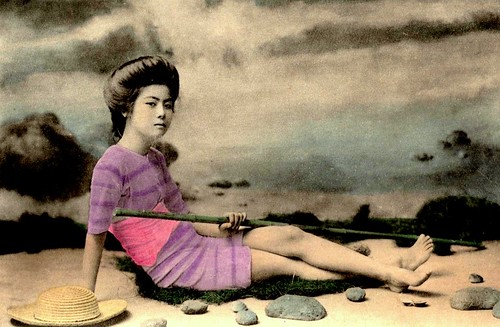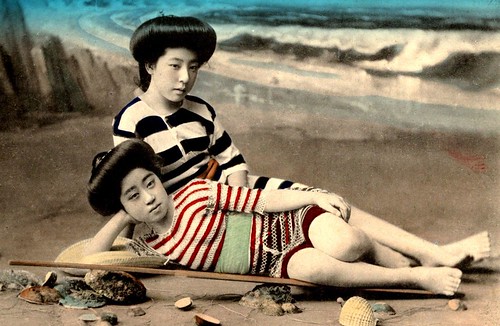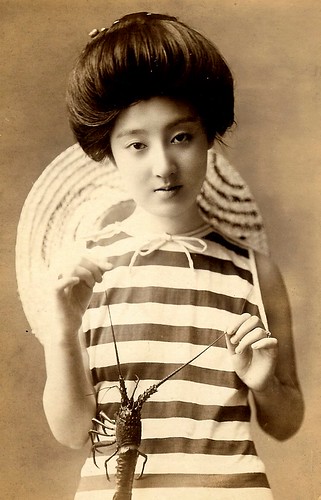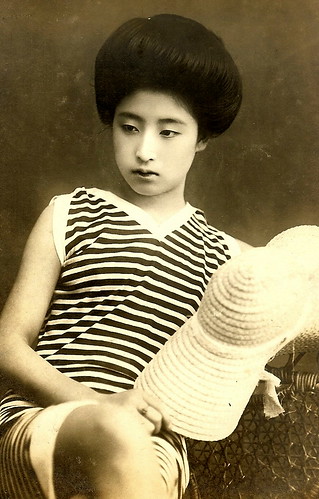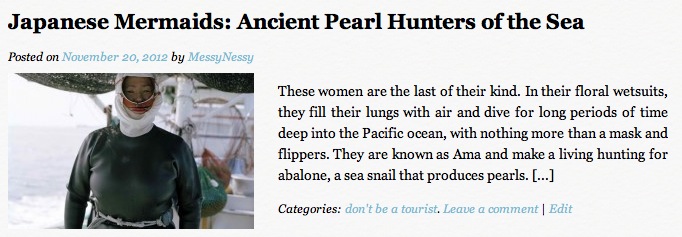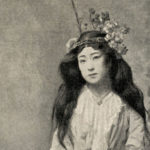Misconceptions about the nature of the geisha profession have been allowed to spread throughout history largely unchecked, and the geisha world has remained to this day a very private, elite world, shrouded in mystery.
These vintage postcards of ‘bathing’ geisha and maiko (apprentice geisha) taken from the Meiji (1868–1912) and Taisho (1912–1926) eras of old Japan, were compiled and scanned by photographer/researcher Rob Oechsle.
As I browsed through his impressive Flickr collection, I read the user comments below about how sweet and cute and pretty the girls all were and felt as if I was the only one with my eyebrow raised. Another article featuring the photographs said, “we think you’ll agree that they definitely have a charm of their own.” Yes, the girls were beautiful and the post-coloring of the photographs is pretty cool, but does anyone else see what is literally, “wrong with this picture”?
Disturbingly young, these geishas posing in “swimwear” can’t be much older than 13 or 14 years-old, some even much younger. Given the era that these photographs were taken, I cannot help but see the sinister side of these photographs.
Despite the culture’s tumultuous past, ‘legitimate geisha do not engage in paid sex with clients’¹. An American anthropologist and novelist specialising in Japanese culture, Liza Dalby, who acted as a consultant to Arthur Golden for the novel Memoirs of a Geisha agrees, “Geisha are paid for their company, not sex”. (This is not to say they did not have affairs with married clients and sometimes had children by patrons).
But she also writes:
“There is no doubt that coerced sex and bidding on a new geisha’s virginity occurred in the period before WWII… After Japan lost the war, geisha dispersed and the profession was in shambles. When they regrouped during the Occupation and began to flourish in the 1960s during Japan’s postwar economic boom, the geisha world changed.”
In the 1900s before the war, when these photos were taken, the auctioning of a maiko’s virginity was a relatively normal practice. It was not outlawed until 1959– although isolated incidents of it have been reported as recently as 2001.
Even if we were to ignore the conflicting history of the geisha, the photographs are still haunting. While the girls, stripped of their traditional kimonos, are supposed to be at the beach, it’s clear these photos were taken within the confines of a photographer’s studio, with fake backgrounds, seaside props and most worryingly, away from supervising eyes.
“From roughly the 1870s until the early 1920s, geisha pretty much owned the world of fashion and character modelling throughout the photo studios of Japan,” says Rob Oechsle. “The photographers … needed poised and pretty models who knew how to take direction as they posed in all manner of studio dress… and sometimes undress.”
At a time when photography was becoming hugely popular in Japan, these postcards of young geisha were being sold just about everywhere.
The expressions on many of the girls faces say that they would most definitely like to be somewhere else, playing outside with other children their age.
Maiko (apprentice geisha) are also known by the generic term o-shaku, literally “one who pours (alcohol)”². Geishas, shadowed by their maiko, were trained to entertain high-class social gatherings attended by powerful male figures in Japanese society, hardly appropriate company for young young girls.
The second world war saw a decline in the geisha arts when women were forced to work in factories for Japan. During this time, the true nature of the geisha became even more confusing when many of the professional prostitutes began referring to themselves as “geisha girls” to American military and occupying soldiers. And it wasn’t just the foreigners who mistook geishas for high class prostitutes– even Japanese officials were recorded to have similar ‘confusion’ in the 19th century.
Today, geishas are strictly known as traditional Japanese female entertainers who act as hostesses and performers. Their purpose is to entertain their customer, be it by playing classical instruments, dancing, reciting verse, playing traditional games or engaging in light conversation.
“In modern Japan, girls are not sold into indentured service, nor are they coerced into sexual relations. Nowadays, a geisha’s sex life is her private affair,” says expert Liza Dalby.
Entertaining however, may involve subtle flirting with clients and using playful innuendos to keep them amused. Indeed, the allure for men today is perhaps the amusement of the forbidden fantasy.
Thanks to the Flickr account of all things interesting, Okinawa Soba
:::
YOU MIGHT ALSO LIKE:



